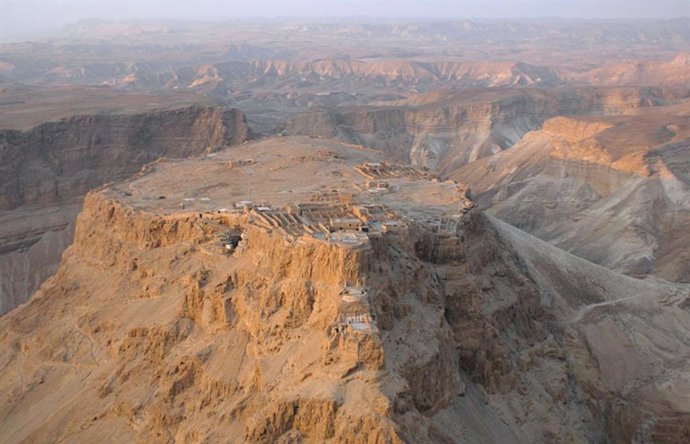Aerial view of the ancient fortress of Masada, with the assault ramp built by the Romans on the right – WIKIMEDIA COMMONS
September 6 () –
Contrary to the widespread myth of a Jewish resistance that lasted for yearsThe Roman army’s iconic siege of Masada in 73 AD lasted no more than a few weeks.
Researchers at Tel Aviv University’s (TAU) Sonia & Marco Nadler Institute of Archaeology have used a variety of modern technologies, including drones, remote sensing and 3D digital modeling, to reach that conclusion of shape and “objective and quantified”. The work is published in the Journal of Roman Archaeology.
Dr. Guy Stiebel, first author of the research, explains: “In 2017, my expedition renewed, on behalf of the Sonia & Marco Nadler Institute of Archaeology at TAU, the excavations at Masada, a world-famous site that has been extensively explored since the beginning of the 19th century and throughout the 20th century. Our expedition raises several new questions and implements many novel research tools that were not available to previous generations of archaeologists. In this way, we aim to gain new insights into what really happened there before, during and after the Great Jewish Revolt.
“As part of this extensive project, we devoted a lot of academic attention to the surroundings of the site. We used Drones, remote sensing and aerial photography to collect accurate, high-resolution data of Masada and its surroundings, with particular emphasis on three aspects: the water systems, the paths leading to and from the palace fortress, and the Roman siege system.
“The information collected is used to build 3D digital models that give us a clear and accurate picture of the relevant terrain. In the current study we focus on the siege system, which, thanks to the remote location and desert climate, It is the best preserved Roman siege system in the world.”
He added: “For many years, the prevailing theory that has become modern myth claimed that the Roman siege of Masada was a gruelling three-year affair. In recent decades, scholars have begun to question this notion, for several reasons. In this pioneering study, we examine the problem with modern technologies that enable precise objective measurements.”
The researchers used remote-sensing drones that provided precise, high-resolution measurements of the height, width and length of all features of the siege system. This data was used to build an accurate 3D digital model, allowing for an accurate calculation of the volume of the structures and the time it took to build them.
THE SIEGE WAS COMPLETED IN TWO WEEKS
Co-author Hay Ashkenazi of the Israel Archaeology Authority continues: “There are reliable estimates of how much earth and stone a Roman soldier was able to move in a day. We also know that Approximately 6,000 to 8,000 soldiers took part in the siege of Masada. Thus, we were able to objectively calculate how long it took them to build the entire siege system: eight camps and a stone wall surrounding most of the site. We found that construction took only about two weeks.
“Based on ancient historical evidence, it is clear that once the assault ramp was completed, The Romans launched a brutal attackand eventually captured the fortress in a few weeks at most. This leads us to the conclusion that The siege of Masada lasted no more than a few weeks.”
Dr. Stiebel states: “The narrative of Masada, the Great Jewish Revolt, the siege and the tragic end, as related by Flavius Josephus, have become part of the Israeli DNA and the Zionist spiritand are well known throughout the world. The length of the siege is an important element of this narrative, suggesting that the glorious Roman army found it very difficult to take the fortress and crush its defenders. For many years it was assumed that the siege lasted three long years, but in recent decades researchers have begun to question this unfounded belief.
“In our first study of its kind, we used objective measurements and advanced technologies to clarify this question with the first data-driven scientific answer. Based on our findings, we argue that the Roman siege of Masada lasted a few weeks at most. As empires have done throughout history, the Romans came, saw and conquered, quickly and brutally suppressing the uprising in this remote place.
“Our conclusion, however, does not diminish the importance of this historic event, and many puzzling questions remain to be investigated. For example, why did the Romans put so much effort into seizing this remote and seemingly unimportant fortress?















Add Comment